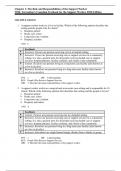Prüfung
Test Bank for Sorrentino's Canadian Textbook for the Support Worker, 5th Edition by Wilk
- Kurs
- Hochschule
Test Bank for Test Bank for Sorrentino's Canadian Textbook for the Support Worker, 5th Edition by Wilk. Full Chapters are included 1. The Role and Responsibilities of the Support Worker 2. The Canadian Health Care System 3. Workplace Settings 4. Ethics 5. Legislation: The Client’s Rights a...
[ Mehr anzeigen ]



